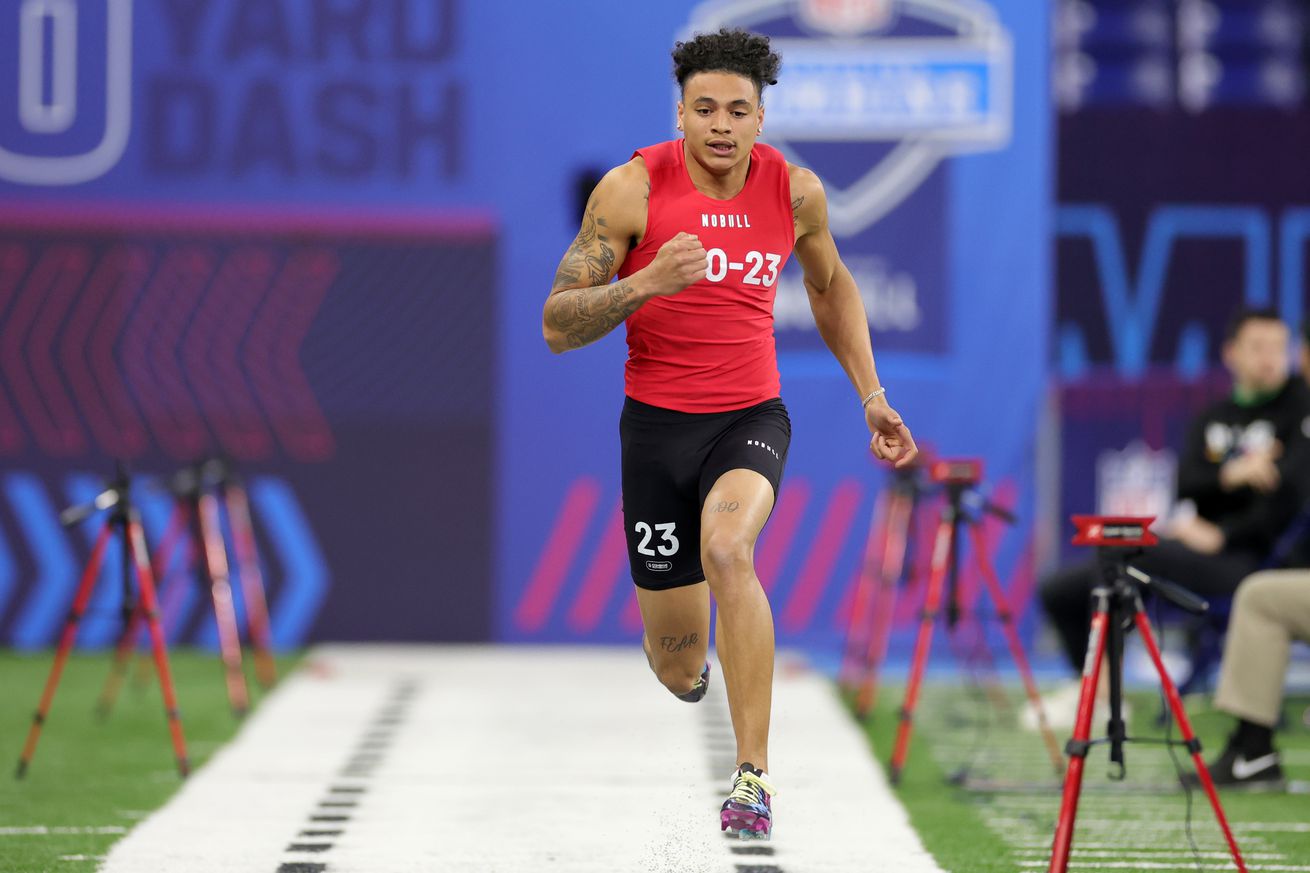
The parts we see on TV, not so much
The NFL Scouting Combine going on in Indianapolis this week is, from a cynic’s point of view, one of several made-for-TV ways the NFL has devised to masterfully keep their public’s attention for most of 12 months for a sport whose season actually only lasts for a little more than five months.
For general managers and coaches, it is more than that, because they get to meet with prospects and begin their in-depth evaluation of them. It’s also a place where GMs meet with player agents and have informal discussions prior to looming contract negotiations. None of that does much good for fans, though, who are not privy to these behind-the-scenes goings-on. Yes, we get to hear from the “NFL insiders” about what’s going on out of view of the cameras, what the rumor mills are cranking out, and so on. As New York Giants fans, we get to listen to Joe Schoen doing his best to try to reveal nothing in an entire interview about the Giants’ plans for the offseason.
What fans do get to see, though, are the various drills and workouts by prospects who choose to show up and participate. We swoon or moan over the “relative athletic scores” put together by Kent Lee Platte. Not that this is a bad thing, but it sure isn’t everything, e.g.,
Puka Nacua is a WR prospect in the 2023 draft class. He scored a 5.15 #RAS out of a possible 10.00. This ranked 1476 out of 3040 WR from 1987 to 2023. https://t.co/id4MVauhiB pic.twitter.com/kRS5uMRWVp
— Kent Lee Platte (@MathBomb) April 11, 2023
Nacua went at No. 177 in the fifth round. I think he has a decent chance to make the Rams’ 53 in his second season and avoid the practice squad.
The question is: Are we kidding ourselves with all these drills that will happen later in the week? Is it just for show and not for dough? Does how fast a football player runs, how much weight he can lift, how quickly he can change direction actually predict success in the NFL?
Kevin Cole of Unexpected Points has analyzed 15 years of Combine results to see which ones best correlate with NFL success. His study builds on work done almost a decade ago by Bill Lotter of the Harvard Sports Analysis Collective on why the Combine actually matters. Here are some of Cole’s results for the offensive side of the ball. I’ll discuss the defense in a second article. Cole evaluates player NFL success by calculating for each one an expected points added (EPA) relative to similar players of the same “type,” resulting in a “Plus/Minus” number for each one. Think of it as being in the spirit of a wins-over-replacement (WAR) sort of number but for EPA.
[Aside for geeks (skip this if you want to go right to the Combine results): “Type” is defined by using a principal components analysis that segregates players into one of a number of k-means clusters based on certain statistics. For example, for wide receivers, it looks like this:
/cdn.vox-cdn.com/uploads/chorus_asset/file/25308828/clusters.jpg)
Courtesy of Unexpected Points
The dotted lines show seven stats that are used to differentiate receiver types. For each individual player he calculates the EPA above/below the typical player in that cluster (“Plus/Minus”). Overall, the blue (“Tyreek Hill”) cluster is the most valuable. Translation: With the No. 6 pick, the Giants may well be looking for a Marvin Harrison Jr./Malik Nabers/Rome Odunze type of player who can maximize first downs, yards per route, touchdowns the way players like Hill, CeeDee Lamb, etc. do. The “Gabe Davis cluster”, which maximizes yards per reception, is second most valuable, and the “Wan’Dale Robinson cluster” of primarily slot players is third. The “Jalin Hyatt cluster” is inhabited by players who run deep routes a lot but are rarely targeted, which gives them little value above average. The question is whether Hyatt will migrate into the Davis or Hill cluster as his career progresses.
OK, geek stuff finished.]
Cole asks how much NFL value (as defined by his Plus/Minus score for each player) can be attributed to specific Combine results as measured by his Plus/Minus metric, and also asks how the same Combine results are related to how high a given player is drafted. Let’s look at specific positions.
Wide receivers
/cdn.vox-cdn.com/uploads/chorus_asset/file/25308870/WR_combine.jpg)
Courtesy of Unexpected Points
The blue bars in the chart above show that the NFL falls in love with big wide receivers who have long arms and run a fast 40-yard dash and draft them high. No surprise there. The much shorter red bars show that these things do not matter much to actual success in the NFL. Of all the drills the 40 matters the most, but not much. Vertical jump, broad jump, hand size and the vaunted 3-cone agility/change of direction drill are actually slightly negatively correlated with NFL success. If your favorite receiver prospect does poorly in any of these drills…don’t worry. Worry more about whether he’s good at football.
Running backs
/cdn.vox-cdn.com/uploads/chorus_asset/file/25308883/RB.jpg)
Courtesy of Unexpected Points
For running backs Combine drills provide a little more information. Once again, the NFL loves speed. They shouldn’t. What they should value is agility, as measured by the 3-cone drill, which actually seems to capture an attribute that matters to some extent.
Tight ends
/cdn.vox-cdn.com/uploads/chorus_asset/file/25308916/TE.jpg)
Courtesy of Unexpected Points
NFL general managers love fast tight ends who can jump far. In reality, bigger tight ends are more successful, all things being equal. Who could possibly have guessed?
Offensive tackle
/cdn.vox-cdn.com/uploads/chorus_asset/file/25308925/OT.jpg)
Courtesy of Unexpected Points
The NFL is suspicious of short-armed tackles coming out of college and often try to move them inside to guard. It’s not always true, e.g., Rashawn Slater has done just fine at OT in the NFL with short arms. Overall, though, the chart above shows that there’s something to the idea, in fact a little more than the NFL gives it credit for. It slightly penalizes being small, but results suggest that doesn’t matter. Once again, the NFL loves speed, but for tackles, agility as measured by the vertical jump, 3-cone, and shuttle drills matter as well.
Interior offensive linemen
/cdn.vox-cdn.com/uploads/chorus_asset/file/25308935/IOL.jpg)
Courtesy of Unexpected Points
The NFL likes its IOLs to be big with long arms, to be fast, and to be agile. They’re right about the agility part, wrong about the rest.
Quarterbacks
For reasons unknown, Cole did not include quarterbacks in his analysis. However Tej Seth of Sumer Sports did his own analysis of quarterbacks with the following results:
happy combine week to those who celebrate. here are the combine events to look out for this week for each offensive position
article: https://t.co/2dnYF3qGS4 pic.twitter.com/m12CCJ757Q
— Tej Seth (@tejfbanalytics) February 27, 2024
Cole suggests that the age correlation in Seth’s analysis occurs because QBs who know they are going to be drafted high choose to come out of school earlier. Maybe the most interesting thing in the chart above is that QB height has little relationship to NFL productivity overall. That may be a surprise since one of the knocks on Baker Mayfield has been that he has trouble seeing over the defensive line, and because Bryce Young’s poor first year was blamed by some on his small stature.
Add to these results the fact that C.J. Stroud, wildly successful as a rookie, scored very poorly on the trendy S2 cognition test, and we have to ask: What are we actually doing here? The answer is: The part you see on TV is mostly for show, whether NFL GMs realize it or not. The real Combine is happening this week behind closed doors.



















You must be logged in to post a comment Login